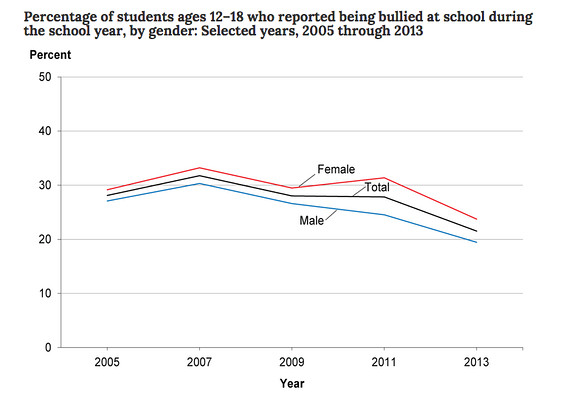Why Bullying Rates Are Down

By:
Last week, I published an ATTN: story about my not-so-pleasant childhood experiences with bullying, which researchers say can follow victims into adulthood. Luckily, school bullying rates for students age 12 to 18 actually dropped to 22 percent in 2013 after climbing to nearly 30 percent in 2005, 2009, and 2011, a new report by the Department of Education found. Cyberbullying, which can happen on Facebook, Instagram, Twitter, and other social media platforms, also decreased for this age group.
 MarketWatch - marketwatch.com
MarketWatch - marketwatch.com
Who is getting bullied the most?
As to be expected, bullying is the worst for middle schoolers and becomes less of a problem later in high school. The findings revealed more than a quarter of sixth graders were bullied versus just 14 percent of high school seniors. Bullying also appears to be worse for girls. In the 12 to 18 age group, almost a quarter of girls reported being bullied whereas only 19 percent of boys said that they'd been harassed at school. White and Black students reported experiencing higher rates of bullying than their Hispanic and Asian counterparts.
David Esquith, director at the Office of Safe and Healthy Students at the Department of Education, told MarketWatch that bullying was most likely to happen in between classes, but it often takes place in class as well. Children reported instances of bullying to adults less than half the time, according to the research.
Why it's happening less
The work of anti-bullying organizations seem to be working, Esquith told MarketWatch.
“Anti-bullying campaigns at the federal, state, and local level may be paying off,” Esquith said. “Parents and schools and students are also working together to prevent it and help those kids who are being bullied.”
While Esquith is happy that the national spotlight on bullying has improved the lives of young school children, he said that "there’s still a lot of work to be done."
Often, it takes more than a single intervention with an adult for bullies to quit harassing other students, G. A. Buie, a longtime school administrator in Kansas and president of the National Association of Secondary School Principals, told AOL.
"I hope that it stops," Buie said. "The reality is it's a learned behavior from kids, and they are probably going to target someone else or go back and target the individual again."
Education Secretary Arne Duncan also cautiously applauded the bullying decrease in a statement.
"Even though we've come a long way over the past few years in educating the public about the health and educational impacts that bullying can have on students, we still have more work to do to ensure the safety of our nation's children."
With more bully-related suicides popping up in the news, the fight definitely isn't over. As ATTN: also reported last week, a new study from the Lancet medical journal shows that bullying can lead victims to have mental health issues later in life. The research also revealed that, compared to kids abused by adults, kids who are bullied by other kids have a greater probability of developing certain mental health problems such as anxiety, self-harm, and depression.
"The major message for us is not to say [bullying] is worse [than maltreatment] because both things are really bad for children," study author Dr. Dieter Wolke told ATTN:. "The U.N. Convention On the Rights Of the Child states very clearly that we have to protect children from abuse and neglect from caretakers and parents, but it doesn't include protecting them from peers, which could also be siblings, but in particular peers at school. So we've got a lot of things in place like social workers, police, teachers, etc., working together on maltreatment, but the same is not in place in dealing with severe bullying. And I think that's the major message that we want to bring across."
